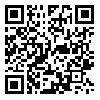BibTeX | RIS | EndNote | Medlars | ProCite | Reference Manager | RefWorks
Send citation to:
URL: http://jams.arakmu.ac.ir/article-1-2249-en.html
2- Department of Biology, Genetics Division, Faculty of Science, University of Isfahan, Isfahan, Iran
3- 1- Cellular and Molecular Research Center, Shahrekord University of Medical Sciences, Shahrekord, Iran ,
Background: SLC26A4 gene mutations are the second currently identifiable genetic cause of autosomal recessive non syndromic hearing loss (ARNSHL) after GJB2 mutations. In databases, several potential STR markers related to this region have been introduced. In this investigation, the identity and informativeness of D7S2459 CA repeat STR marker in SLC26A4 gene region was examined in five ethnic groups of the Iranian population.
Materials and Methods: The research study was accomplished by genotyping the locus in 165 individuals of five different ethnic groups including Fars, Azari, Torkaman, Gilak and Arab using polymerase chain reaction (PCR) followed by polyacrylamide gel electrophoresis (PAGE) and fluorescent capillary electrophoresis. In this study, results were analyzed by GeneMarker HID Human STR Identity software, GenePop program and Microsatellite Tools software.
Results: Analysis of the allelic frequency revealed the presence of 8 alleles for D7S2459 marker in the Iranian population. Among all, allele 148bp at the D7S2459 locus with 31% frequency was the most frequent. The Azari ethnic with 84.8% observed heterozygosity was the highest among all ethnic groups. Finally, analysis of PIC value revealed that D7S2459 marker could be considered as a highly informative marker in each ethnic of the Iranian population (PIC value above 0.7).
Conclusion: Our data suggested that D7S2459 could be introduced as a highly informative marker in molecular diagnosis of SLC26A4 based ARNSHL by Linkage analysis.
Received: 2013/04/5 | Accepted: 2013/09/23
| Rights and permissions | |
 |
This work is licensed under a Creative Commons Attribution-NonCommercial 4.0 International License. |





